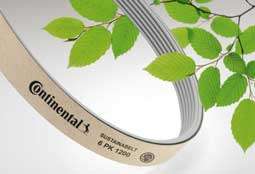Technology firm Continental will debut a new timing belt with a profile side made not from polychloroprene, but from a new and patented synthetic rubber compound at the Automechanika show (September 13-17, Frankfurt). Though it did not state what the material content is, the German firm says it has many benefits for the environment as it generates 50% lower carbon footprint. The new timing belt is ready for series production and is slated for introduction worldwide up to the middle of 2023, it adds.
“The raw materials used already have a significantly lower global warming potential,” says Hermann Schulte, responsible for the Timing Belt Development for the Automotive Aftermarket at Continental. “And the new compound generates an around 50% smaller carbon footprint – from its manufacture to the disposal of the belt.”
There are also some interesting technical pluses: The new timing belts enable higher power transmission and offer improved cold and heat resistance.
Continental adds it is showcasing the potential of drive belts to enhance sustainability and climate protection with its SUSTAINABELT belt study. “This belt brings together pretty much everything our development engineers have come up with in terms of sustainability,” explains Karim Fraiss, responsible for the product range at Continental as Head of Product Line Management Automotive. “This includes tension members and fabric made with organic fibres and biopolymers from renewable raw materials.”
Continental will also introduce a new packaging concept for its accessory drive kits with water pump. Previously, the individual components of these kits (belts, water pump, tensioner pulleys, etc.) have been packed into individual boxes, which are then stacked together in a large outer box. In future, however, a specially folded cardboard insert will ensure that all components are held securely in place with good protection inside the box without the need for individual packaging. This means only half the amount of cardboard has to be produced, significantly reducing CO2 emissions.
“There are also other climate-?relevant advantages when it comes to transportation,” adds Anna Bentlage from Projects and Standards at Continental Power Transmission Group Automotive: “Since the new packaging is lighter and smaller, haulage companies will be able to transport just under 70% more belt drive kits with water pump on a pallet. And that substantially increases operating and fuel efficiency. By our calculations, this cuts our CO2 emissions by around 390 tons annually.”
Added to which, the cardboard used for the new kit packaging is made entirely from recycled material and is itself recyclable. Dealers gain from having significantly more space on their shelves, while workshops can enjoy easier handling when unpacking, greater clarity in their workplaces and a lot less
cardboard packaging waste.


